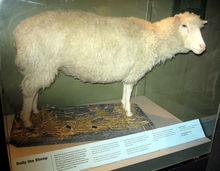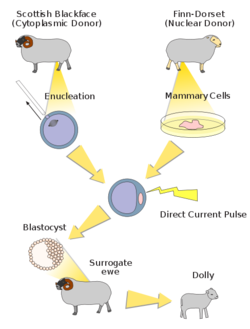
Dolly (5 July 1996 – 14 February 2003) was a female domestic sheep, and the first mammal to be cloned from an adult somatic cell, using the process of nuclear transfer. [1][2] She was cloned by Ian Wilmut, Keith Campbell and colleagues at the Roslin Institute near Edinburgh in Scotland. She was born on 5 July 1996 and she lived until the age of six.[3] She has been called "the world's most famous sheep" by sources including BBC News and Scientific American.[4][5]
The cell used as the donor for the cloning of Dolly was taken from a mammary gland, and the production of a healthy clone therefore proved that a cell taken from a specific part of the body could recreate a whole individual. As Dolly was cloned from part of a mammary gland, she was named after the famously curvaceous country western singer Dolly Parton.[6][7]
Birth

This used the technique of somatic cell nuclear transfer, where the cell nucleus from an adult cell is transferred into an unfertilised oocyte (developing egg cell) that has had its nucleus removed. The hybrid cell is then stimulated to divide by an electric shock, and when it develops into a blastocyst it is implanted in a surrogate mother.
In the previous year, the same team had produced cloned sheep from the embryonic cells,[8] but this was not seen as a breakthrough since adult cloned animals had been produced from embryonic tissue as long ago as 1958, using cells from the frog Xenopus laevis.[9]
Dolly was the first clone produced from a cell taken from an adult mammal. However, the South African frog (Xenopus laevis) was cloned from an adult intestinal cell in 1962 by John Gurdon and the Asian carp was cloned in 1963 by Tong Dizhou.[10] The production of Dolly showed that genes in the nucleus of such a mature differentiated somatic cell are still capable of reverting back to an embryonic totipotent state, creating a cell that can then go on to develop into any part of an animal.[11] However, this reprogramming process is not perfect and embryos produced by nuclear transfer often show abnormal development.[12][13]
As a consequence of these difficulties in development, cloning mammals by nuclear transfer is still highly inefficient, with Dolly the only lamb that survived to adulthood from 277 attempts. However, her birth is still recognised as one of the major stepping stones in the development of modern biology.[2] Wilmut, who led the team that created Dolly, announced in 2007 that the nuclear transfer technique may never be sufficiently efficient for use in humans.[14]
Life
Dolly lived for her entire life at the Roslin Institute in Edinburgh. There she was bred with a Welsh Mountain ram and produced six lambs in total. Her first lamb, named Bonnie, was born in April 1998.[3] The next year Dolly produced twin lambs Sally and Rosie, and she gave birth to triplets Lucy, Darcy and Cotton in the year after that.[15] In the autumn of 2001, at the age of five, Dolly developed arthritis and began to walk stiffly, but this was successfully treated with anti-inflammatory drugs.[16]
Death
On 14 February 2003, Dolly was euthanised because she had a progressive lung disease and severe arthritis.[17] A Finn Dorset such as Dolly has a life expectancy of around 11 to 12 years, but Dolly lived to be only six years of age. A post-mortem examination showed she had a form of lung cancer called Jaagsiekte,[18] which is a fairly common disease of sheep and is caused by the retrovirus JSRV.[19] Roslin scientists stated that they did not think there was a connection with Dolly being a clone, and that other sheep in the same flock had died of the same disease.[17] Such lung diseases are a particular danger for sheep kept indoors, and Dolly had to sleep inside for security reasons.
Some have speculated that a contributing factor to Dolly's death was that she could have been born with a genetic age of six years, the same age as the sheep from which she was cloned.[20] One basis for this idea was the finding that Dolly's telomeres were short, which typically is a result of the ageing process.[21][22] The Roslin Institute have stated that intensive health screening did not reveal any abnormalities in Dolly that could have come from advanced ageing.[20]
Legacy
After cloning was successfully demonstrated through the production of Dolly, many other large mammals have been cloned, including horses and bulls.[23] The attempt to clone argali sheep did not produce viable embryos. The attempt to clone a banteng bull was more successful, as were the attempts to clone mouflon (a form of wild sheep), both resulting in viable offspring.[24]
Cloning may have uses in preserving endangered species and be important in the future production of transgenic livestock,[25][26] cloning does not directly alleviate the problems of loss of genetic diversity (except insofar as it allows individual germ lines that would otherwise become extinct to be preserved) and loss of habitat, and so must be considered an experimental and expensive technique for the time being, compared to conventional techniques such as captive breeding or embryo transfer.[27]
Cloning may become a viable tool for reviving extinct species. In January 2009, scientists from the Centre of Food Technology and Research of Aragon, in Zaragoza, northern Spain announced the cloning of the Pyrenean ibex, a form of wild mountain goat, which was officially declared extinct in 2000. Using DNA from skin samples kept in liquid nitrogen the scientists managed to clone the Ibex from domestic goat egg-cells. The newborn ibex died shortly after birth due to physical defects in its lungs. However, it is the first time an extinct animal has been cloned, and may open doors for saving endangered and newly extinct species by resurrecting them from frozen tissue.[28] It has also renewed interest in the possibility that in the future it will be possible to reproduce long-dead species such as woolly mammoths and even dinosaurs.
http://encyclopedia.thefreedictionary.com/p/Dolly%20the%20sheep
No comments:
Post a Comment